See also
| This disambiguation page lists articles associated with the title Handcuffs. If an internal link led you here, you may wish to change the link to point directly to the intended article. |
Handcuffs are restraint devices.
Handcuff or Handcuffs may also refer to:
| This disambiguation page lists articles associated with the title Handcuffs. If an internal link led you here, you may wish to change the link to point directly to the intended article. |

Hojōjutsu or Torinawajutsu or just Nawajutsu, is the traditional Japanese martial art of restraining a person using cord or rope, as a precursor to modern-day handcuffs. Encompassing many different materials, techniques and methods from many different schools, Hojōjutsu is a quintessentially Japanese art that is a unique product of Japanese history and culture.
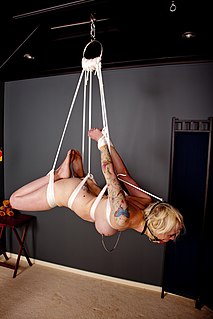
Bondage, in the BDSM subculture, is the practice of consensually tying, binding, or restraining a partner for erotic, aesthetic, or somatosensory stimulation. A partner may be physically restrained in a variety of ways, including the use of rope, cuffs, bondage tape, or self-adhering bandage.
Restraint may refer to:
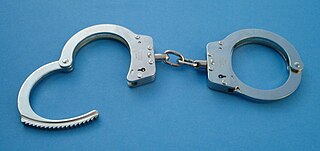
Handcuffs are restraint devices designed to secure an individual's wrists in proximity to each other. They comprise two parts, linked together by a chain, a hinge, or rigid bar. Each cuff has a rotating arm which engages with a ratchet that prevents it from being opened once closed around a person's wrist. Without the key, the handcuffs cannot be removed, and the handcuffed person cannot move his or her wrists more than a few centimetres or inches apart, making many tasks difficult or impossible.
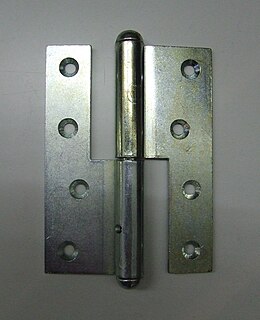
A hinge is a mechanical bearing that connects two solid objects, typically allowing only a limited angle of rotation between them. Two objects connected by an ideal hinge rotate relative to each other about a fixed axis of rotation: all other translations or rotations being prevented, and thus a hinge has one degree of freedom. Hinges may be made of flexible material or of moving components. In biology, many joints function as hinges like the elbow joint.
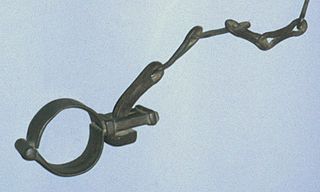
Legcuffs are physical restraints used on the ankles of a person to allow walking only with a restricted stride and to prevent running and effective physical resistance.

Plastic handcuffs are a form of physical restraint for the hands, using plastic straps. They function as handcuffs but are cheaper and easier to carry than metal handcuffs, and they cannot be reused. The device was first introduced in 1965.

A handcuff knot is a knot tied in the bight having two adjustable loops in opposing directions, able to be tightened around hands or feet. The knot itself does not possess any inherent locking action, and thus is not as easy to use for such purposes as the name might suggest.
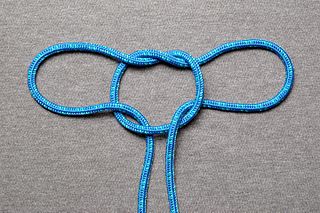
The Tom fool's knot is sometimes considered a handcuff knot but is somewhat inferior for this purpose to the knot which usually bears that name. It is a good knot with which to commence a slightly fancy sheepshank. It is also used as a trick knot due to the speed with which it can be made.

A Prusik is a friction hitch or knot used to attach a loop of cord around a rope, applied in climbing, canyoneering, mountaineering, caving, rope rescue, ziplining, and by arborists. The term Prusik is a name for both the loops of cord and the hitch, and the verb is "to prusik". More casually, the term is used for any friction hitch or device that can grab a rope. Due to the pronunciation, the word is often misspelled Prussik, Prussick, or Prussic.
Thomas Solomon is an American escape artist and magician.

Speedcuffs are a model of handcuff characterised by their rigid grip between the two ratchet cuffs. Their rigid design and the inclusion of a grip makes them effective for gaining control over a struggling prisoner, even if only one cuff has been applied. They were standard issue for most police forces within the United Kingdom.
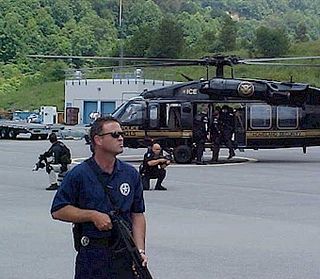
Prisoner transport is the transportation of prisoners by law enforcement agencies or contractors.

A police duty belt is a belt, typically constructed of nylon or leather used by police and security officers to carry equipment easily in a series of pouches attached to the belt, in a readily-accessible manner, while leaving the hands free to interact. This belt can carry any number of useful items, ranging from handcuffs to guns.

Armament Systems and Procedures, Inc., is a US defensive compliance weapons manufacturer providing equipment to law enforcement and private security companies. ASP telescoping batons are widely used.
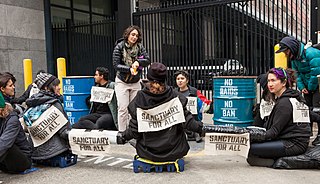
A sleeping dragon is a maneuver used by protesters to cause disruption. It involves handcuffs and PVC pipe: a series of protesters are handcuffed together through the PVC pipe, which precludes police from simply using bolt cutters to break the handcuffs. Advanced variations include covering the PVC pipe with elements which might make it more difficult to break. Examples include chicken wire, tar, and duct tape. Another variation is filling a barrel with concrete and putting the PVC pipe through the barrel such that it cannot be accessed without first destroying all of the concrete.
A belly chain is a physical restraint worn by prisoners, consisting of a chain around the waist, to which the prisoner's hands may be chained or cuffed. Sometimes the ankles are also connected by means of longer chains. ASP, Inc.'s "transport kit"—a belly chain system—was awarded the 2019 Public Safety Product Innovation Award from the North American Association of Uniform Manufacturers and Distributors.
Roslyn Walker is an entertainer. He currently resides in Conwy with his partner, dancer Foxee Stole.

A handcuff cover is a piece of plastic or metal that can be placed around a pair of handcuffs. It consists of a hinged, box-like assembly locked over the handcuff chain, wristlets and keyholes.
Edson Da Costa was a 25-year-old Black Portuguese man who died on 21 June 2017 after being stopped by police on 15 June in Beckton, London. The unclear circumstances of his death led to protests. In June 2019, an inquest jury found that Da Costa died by misadventure from the consequences of a cardiorespiratory arrest after he placed in his mouth a plastic bag containing 88 wraps of class A drugs. The coroner ruled that there was no "legal or factual basis" for a conclusion that could be critical of the police. An investigation by the Independent Office for Police Conduct concluded that the restraint by officers was necessary and proportionate.